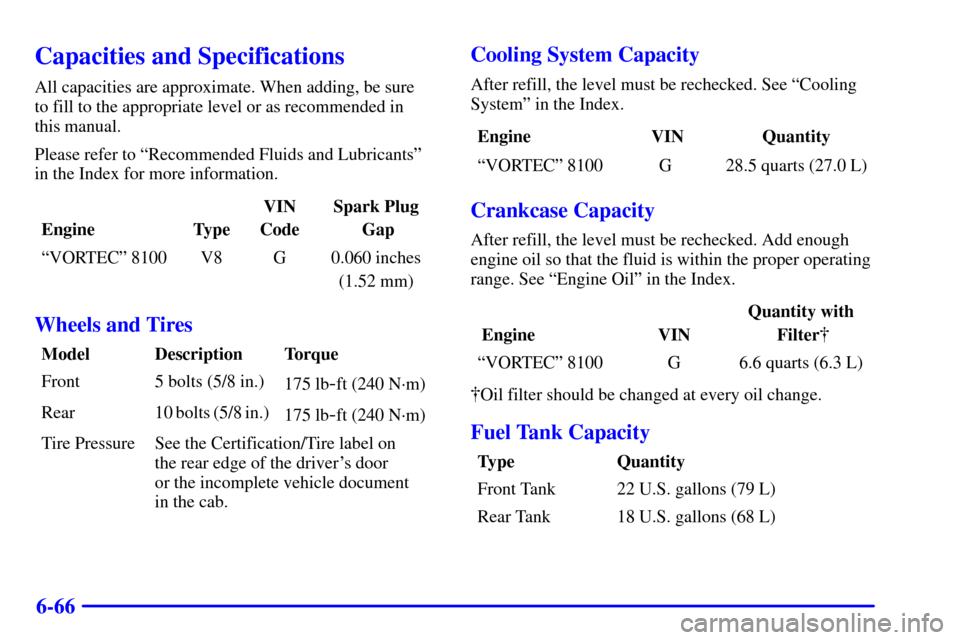Page 230 of 321
6-47
CAUTION:
Rust or dirt on a wheel, or on the parts to which
it is fastened, can make the wheel nuts become
loose after a time. The wheel could come off and
cause an accident. When you change a wheel,
remove any rust or dirt from the places where the
wheel attaches to the vehicle. In an emergency,
you can use a cloth or paper towel to do this; but
be sure to use a scraper or wire brush later, if you
need to, to get all the rust or dirt off.
CAUTION:
Never use oil or grease on studs or nuts. If you
do, the wheel nuts might come loose and the
wheel could fall off, causing a serious accident.
NOTICE:
Improperly tightened wheel nuts can lead to
brake pulsation and rotor damage. To avoid
expensive brake repairs, evenly tighten the wheel
nuts in the proper sequence and to the proper
torque specifications.
Page 233 of 321
6-50
NOTICE:
The wrong wheel can also cause problems with
bearing life, brake cooling, speedometer or
odometer calibration, headlamp aim, bumper
height, vehicle ground clearance and tire or
tire chain clearance to the body and chassis.
Whenever a wheel, wheel bolt or wheel nut is replaced
on a dual wheel setup, check the wheel nut torque after
100, 1,000 and 6,000 miles (160, 1 600 and 10 000 km)
of driving. For proper torque, see ªWheel Nut Torqueº
in the Index. See ªTightening the Wheel Nutsº in the
Index for more information.Used Replacement Wheels
CAUTION:
Putting a used wheel on your vehicle is
dangerous. You can't know how it's been used or
how far it's been driven. It could fail suddenly
and cause an accident. If you have to replace a
wheel, use a new GM original equipment wheel.
Page 249 of 321

6-66
Capacities and Specifications
All capacities are approximate. When adding, be sure
to fill to the appropriate level or as recommended in
this manual.
Please refer to ªRecommended Fluids and Lubricantsº
in the Index for more information.
Engine TypeVIN
CodeSpark Plug
Gap
ªVORTECº 8100 V8 G 0.060 inches
(1.52 mm)
Wheels and Tires
Model Description Torque
Front 5 bolts (5/8 in.)
175 lb
-ft (240 N´m)
Rear 10 bolts (5/8 in.)
175 lb
-ft (240 N´m)
Tire Pressure See the Certification/Tire label on
the rear edge of the driver's door
or the incomplete vehicle document
in the cab.
Cooling System Capacity
After refill, the level must be rechecked. See ªCooling
Systemº in the Index.
Engine VIN Quantity
ªVORTECº 8100 G 28.5 quarts (27.0 L)
Crankcase Capacity
After refill, the level must be rechecked. Add enough
engine oil so that the fluid is within the proper operating
range. See ªEngine Oilº in the Index.
Engine VINQuantity with
Filter�
ªVORTECº 8100 G 6.6 quarts (6.3 L)
�Oil filter should be changed at every oil change.
Fuel Tank Capacity
Type Quantity
Front Tank 22 U.S. gallons (79 L)
Rear Tank 18 U.S. gallons (68 L)
Page 295 of 321

7-45
Part B: Owner Checks and Services
Listed in this part are owner checks and services which
should be performed at the intervals specified to help
ensure the safety, dependability and emission control
performance of your vehicle.
Be sure any necessary repairs are completed at once.
Whenever any fluids or lubricants are added to your
vehicle, make sure they are the proper ones, as
shown in Part D.
At the First 100, 1,000 and 6,000 Miles
(160, 1 600 and 10 000 km)
Check dual wheel nut torque. For proper torque, see
ªWheel Nut Torqueº and ªTightening the Wheel Nutsº
in the Index.
At Each Fuel Fill
It is important for you or a service station attendant to
perform these underhood checks at each fuel fill.
Engine Oil Level Check
Check the engine oil level and add the proper oil if
necessary. See ªEngine Oilº in the Index for
further details.Engine Coolant Level Check
Check the engine coolant level and add DEX
-COOL�
coolant mixture if necessary. See ªEngine Coolantº in
the Index for further details.
Windshield Washer Fluid Level Check
Check the windshield washer fluid level in the
windshield washer tank and add the proper fluid if
necessary. See ªWindshield Washer Fluidº in the
Index for further details.
At Least Once a Month
Tire Inflation Check
Make sure tires are inflated to the correct pressures.
Don't forget to check your spare tire. See ªTiresº in
the Index for further details.
Cassette Deck Service
Clean cassette deck. Cleaning should be done every
50 hours of tape play. See ªAudio Systemsº in the
Index for further details.